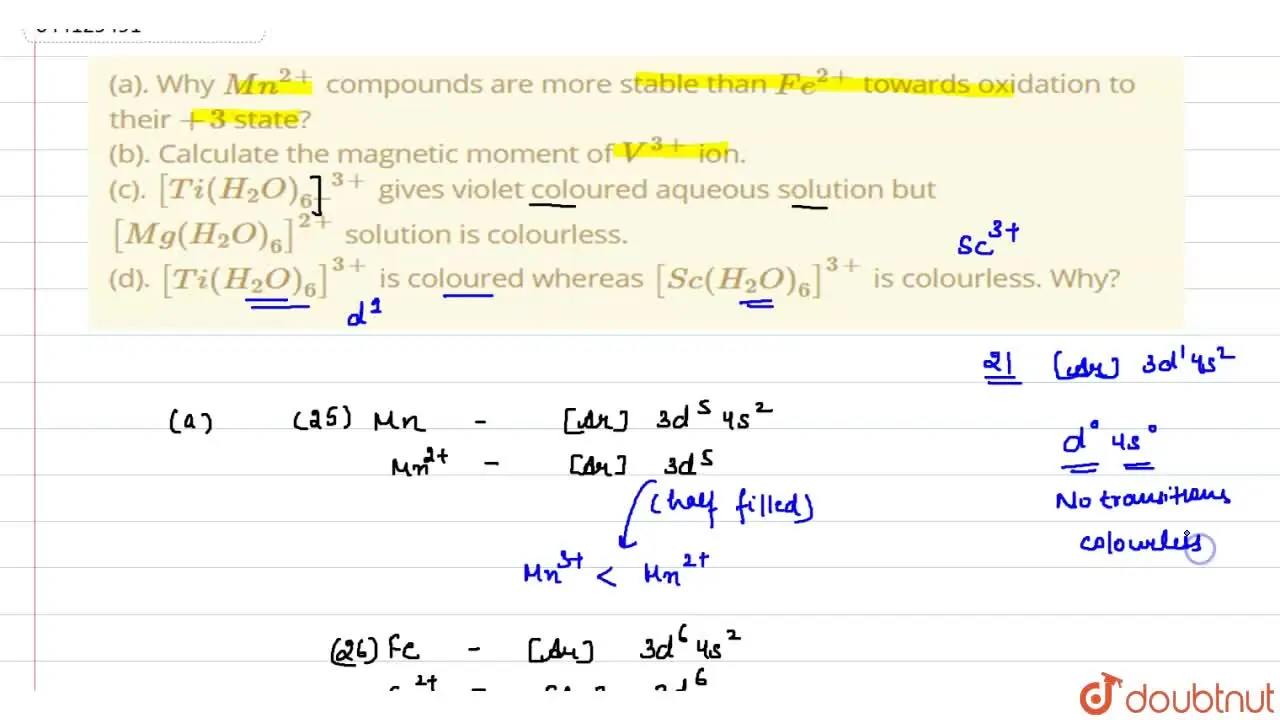(a). Why Mn2+ compounds are more stable than Fe2+ towards oxidation to their +3 state?
(b). Calculate the magnetic moment of V3+ ion.
(c). [Ti(H2O)6_3+ gives violet coloured aqueous solution but
[Mg(H2O)6]2+ solution is colourless.
(d). [Ti(H2O)6]3+ is coloured whereas [Sc(H2O)6]3+ is colourless. Why?
(a). Electronic configuration of Mn2+ is 3d5 which is half filled and hence stable. Therefore IF3 is very high i.e., 3rd electron cannot be lost easily. In case of Fe2+, electronic configuration is 3D6.
(b). V(Z=23)⇒3d34s2,V3+=3d2(n=2)
μ=√n(n+2)BM=√2(2+2)=√8=2.73BM.
(c). In [Ti(H2O)6]3+, the d1 electron occupies t2g orbital in octahedral field. On irradiation with light, the t2g electron is promoted to eg orbital and the resulting absorption band goves violet colour.
In case of [Mg(H2O)6]2+ the electronic configuration of Mg2+ is 1s2, 2p6 which does not permit any electronic transition (2p→3s) as the energy gap is very large or there does not occur d-d transition of electron. Hence, it gives colourless solution.
(d). A in [Ti(H2O)6]3+, the titanium ion is present in Ti3+ form with 3d1, 4s0 configuration. The single upaired electron of 3d1 orbital makes the compound to show colour. In [Sc(H2O)6]3+ scandium is present as Sc3+ state with 3d0,4s0 configuration. Since no electron is present in the 3d and 4 s orbitals, it remains colourless.
Related Playlists
- BOOK - CENGAGE CHEMISTRY ENGLISHCHAPTER - D AND F BLOCK ELEMENTSEXERCISE - Solved Example18videos
D AND F BLOCK ELEMENTS
- BOOK - CENGAGE CHEMISTRY ENGLISHCHAPTER - D AND F BLOCK ELEMENTSEXERCISE - Ex 6.1 Subjective12videos
D AND F BLOCK ELEMENTS
- BOOK - CENGAGE CHEMISTRY ENGLISHCHAPTER - COORDINATION COMPOUNDSEXERCISE - Archives Subjective18videos
COORDINATION COMPOUNDS
- BOOK - CENGAGE CHEMISTRY ENGLISHCHAPTER - ELECTROCHEMISTRYEXERCISE - Archieves Subjective35videos
ELECTROCHEMISTRY
Similar Questions
Why are Mn2+ compounds more stable than Fe2+ toward oxidation to their +3 state?
View Solution[Ti(H2O)6]3+ is coloured while [Sc(H2O)6]3+ is colourless . Explain.
View Solution[Sc(H2O)6]3+ ion is :-
View SolutionFind CFSE of [Ti(H2O)6]3+
View SolutionCalculate magnetic moment of Fe3+ in [Fe(CN)6]3+ and in [Fe(H2O)6]3+
View Solution[Co(H2O)6]3+ complex is
View SolutionA solution of [Ni(H2O)6]2+ is green but a solution of [Ni(CN)4]2− is colourless Explain.
View SolutionAssertion: [Ti(H2O)6]4+ is coloured while [Sc(H2O)6]3+ is colourless.
Reason: d-d transition is not possible in [Sc(H2O)6]3+.View Solution[Co(H2O)6]3+ is diamagnetic wheras [Co(F6)]3−] is paramagnetic. Explain.
View SolutionAssertion : [Ti(H2O)6]Cl3 on heating becomes colourless .
Reason : Water is removed on heating [Ti(H2O)6]Cl3 .View Solution


